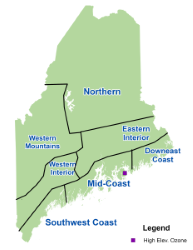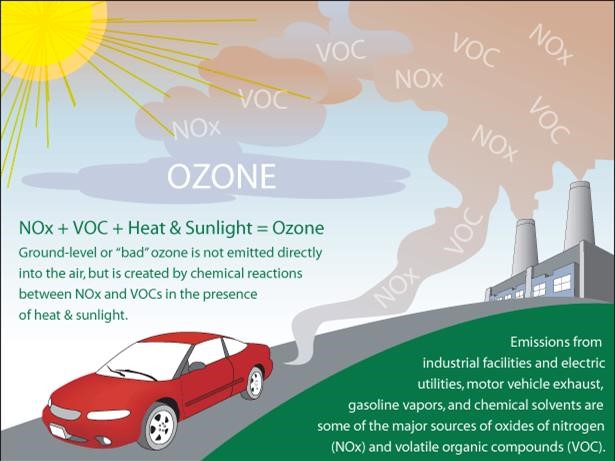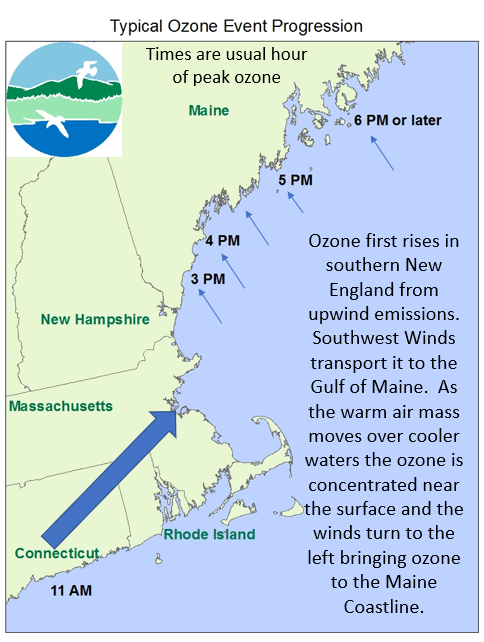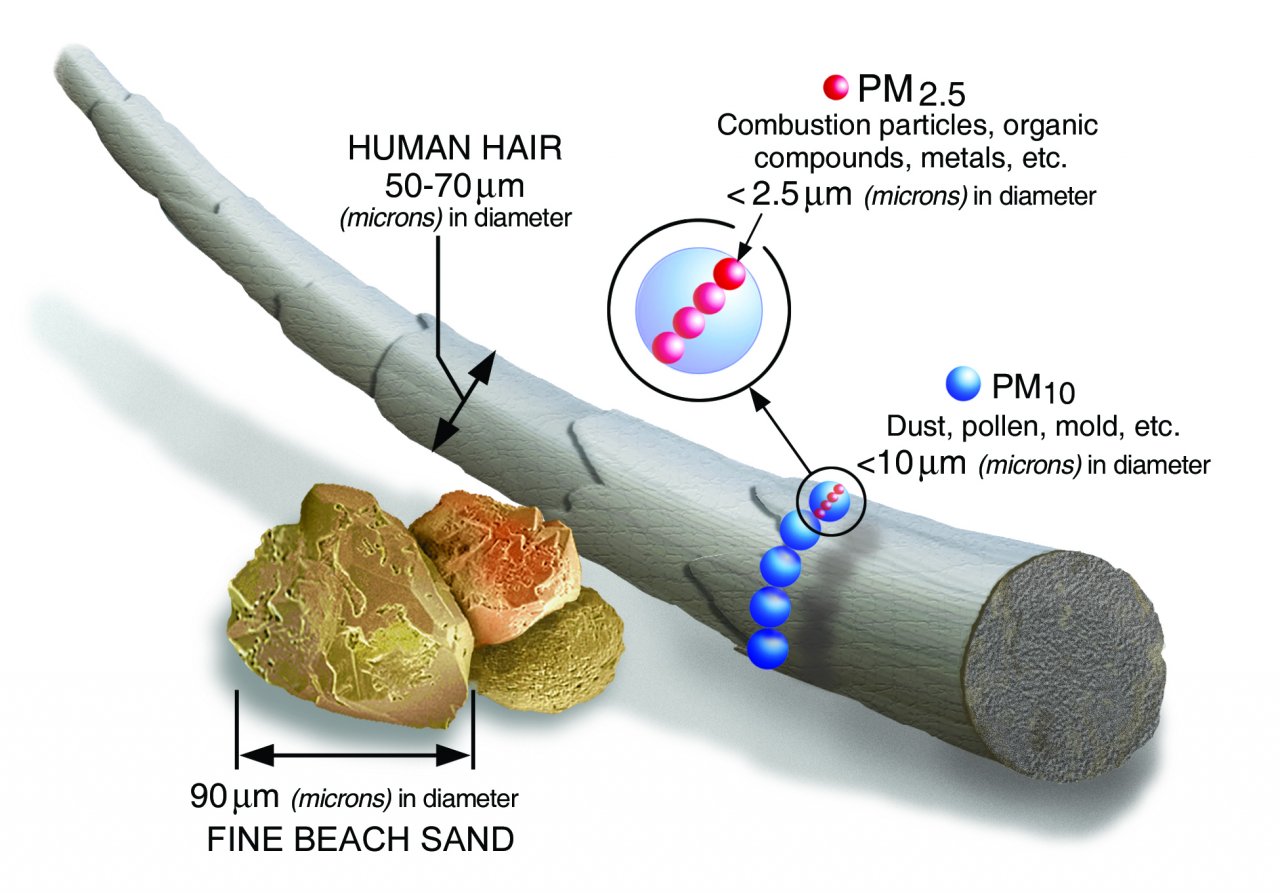Home → Air Quality → Air Quality Forecast → Forecast, Ozone and Particle Pollution
Maine's Air Quality Forecast, Ozone and Particle Pollution
Air Quality Forecast Availability

Click to view larger
DEP Air Quality Meteorologists issue Air Quality Forecasts year-round. These forecasts capture what is expected to be the worst in that region.
Ground-level ozone concentrations are higher during the summer months. Particle Pollution levels tend to be higher during the Summer & Winter and lower during the Spring & Fall.
Since many factors impact pollution levels including terrain & geography, please see Ozone and Particle Pollution specifics below for information to help interpret the forecast for your location.
Maine DEP's Air Quality Forecast web site is the best place to check the forecast because when it is appropriate this page includes more information about the forecast and current air quality than just the forecast that is available on AirNow or independent forecasts on any apps available.
The forecast is made available to the public daily in the following ways:
- 24-hour toll free Air Quality hotline: 1-800-223-1196
- Online in this site - daily forecasts
- EnviroFlash -- Email and text message alert system established by EPA in cooperation with MEDEP.
- AirNow's mobile app -- EPA's AirNow app has a sleek new look and improved functionality! Download the updated app for free on the Apple App Store or the Google Play Store.
- Local Media
When poor air quality is expected Maine DEP also submits Air Quality Alerts to:
- The Citizen Alert System on the State of Maine home page (Maine.gov)
- The National Weather Service's Gray and/or Caribou Offices
As more people rely on mobile apps, and want localized forecasts and data, many options are becoming available. They are likely to use a computer model to approximate a forecast, or current values at specific locations. They may use a different index to present the forecast or data than EPA's Air Quality Index. EPA is working with some of these other sources to try to reduce confusion and present information in similar ways for the benefit of the public.
Ozone
What is it?
- Ozone is an extremely reactive virtually colorless gas comprised of three atoms of oxygen.
- In the upper levels of the atmosphere it shields the earth from the sun's harmful ultraviolet rays.
- However, ozone close to the ground is a harmful pollutant.
- That is why we say, 'Good up high, bad nearby.'
Where does it come from?
- Ozone is formed through a complex chemical reaction between volatile organic compounds (VOCs) and nitrogen oxides (NOx) in the presence of sunlight. Therefore, it is called a photochemical pollutant.
- Sources of manmade VOCs and NOx include: 1) automobiles, trucks and buses; 2) gasoline storage and transfer; 3) large combustion and industry sources such as utilities; 4) industrial use of solvents and degreasing agents; 5) consumer products such as paints and cleaners; 6) off-road engines such as aircraft, locomotives, boats, construction equipment and lawn and garden equipment.
- VOCs are also produced naturally by certain types of vegetation.

How does it behave in Maine?
- By Season – Since ozone needs the sun to form from NOx & VOC's and other precursors, it is most abundant at the surface during the months of the year when the sun is higher in the sky and the days are longer. So, Maine's official Ozone monitoring season is April 1st through September 30th. We do see background levels of ozone begin to rise in late February and into March so higher levels of ozone are possible during these months and we try to get as many of our seasonal monitors up prior to April 1st as we are able depending on accessibility, which may be hindered by lingering snow. As forecasters we begin to pay attention to these background levels in late February.
- By Height – Ozone levels do not drop as readily after the sun sets at high elevation sites such as Cadillac. In fact, Cadillac Mountain's ozone levels frequently peak after 10 PM while low elevation ozone levels are dropping. At this level ozone is more stable and doesn't break down as readily. Also, at this level transport winds have reduced friction from the surface so ozone aloft can travel faster and further than surface ozone. Then, in the morning when the sun begins mixing the air this ozone from aloft can be brought down to the surface.
- By Temperature – Ozone is a very unstable gas. It breaks down readily. Warmer temperatures reduce this instability so that also helps ozone to reach higher levels during the warmer months. HOWEVER, just because it is hot does NOT mean that ozone levels will be high in Maine. Maine's ozone levels are the result of how much ozone and its precursors are transported to the state. If the transport winds are coming from areas that have had low ozone levels, then there isn't much for the wind to bring to Maine. We have had some very hot summers with very few days when ozone reaches the 'Unhealthy For Sensitive Groups' range.
- By Geography & Terrain – After years of analyzing ozone values in Maine we have learned that during the warmer months' ozone varies across the state. Sunshine heats land faster and more than water. The cooler water in the Gulf of Maine causes the air to concentrate pollutants in a shallow layer just above the surface of the water. Additionally, this same impact changes the wind direction and turning the winds toward the Maine coast. As the day progresses ozone and its precursors continue to move eastward along the Maine coast. This is one of the factors that contributes to higher ozone levels along Maine's coast. After the leaves are fully out on the trees, the vegetation removes ozone from the air as it moves inland. So even one town in from the coast ozone levels will be lower than right along the coast. One minor exception is that river valleys can channel air moving inland from the coast and thus concentrate ozone levels a bit higher than ozone levels outside of the valley.

Particle Pollution
What is it?
Particle pollution is a term for pollution that includes both solid particles (dust, dirt, soot, smoke, etc.) and liquid droplets found in air. Particles come in a wide range of sizes. Particles less than 10 micrometers in diameter can be inhaled and accumulate in the respiratory system. Particles less than 2.5 micrometers are called 'fine particles'. This is the size range included in the particle pollution forecast.

Where does it come from?
Some particles are emitted directly into the air. They come from a variety of sources such as: cars, trucks, buses, locomotives, ships, factories, construction sites, tilled fields, unpaved roads, stone crushing, and the burning of wood.
Other particles form in the air from chemical processes. They are indirectly formed when gases from fuel combustion react with sunlight and water vapor.
How does it behave in Maine?
- Summer -- Maine's summertime particle pollution values can rise due to a 'dirty air mass' moving over the state. Large slow-moving High-Pressure systems can pick up pollution as they move across the country. The slower they move, the dirtier they are when they reach the eastern US. In recent years the particle pollution emissions have dropped and so Maine is not impacted as often by very dirty air. In fact, in recent years summer particle pollution levels in Maine have been lower than winter particle pollution levels.
- Winter -- In Maine, wintertime particle pollution values are primarily due to build up during nocturnal inversions. An inversion is like a cap that prevents air from moving upward. Wintertime nocturnal inversions are more likely when it is calm, clear and cold. Clouds help to keep things warmer, so the inversions are likely to be weak or not form at all in cloudy conditions.
- Terrain & Population – Terrain also impacts particle pollution levels. While wintertime nocturnal inversions occur everywhere, particle pollution levels will be highest in valleys and urban areas with more sources and lower in more open, elevated and less populated areas.
- Coarse Particles -- Also, during the winter months in Maine coarse particles (2.5 to 10 micrometers) can be an issue around and downwind of roads and parking lots. When sand & salt have a chance to dry out after storms they can be stirred up by wind & traffic causing higher levels of coarse particles nearby. These particles usually settle out soon after being mixed into the air, so the impacts are highly localized.
How You Can Help
- Combine errands, reduce trips
- Conserve energy - at home, work, everywhere
- Use environmentally safe paints and cleaning products
- Conserve electricity and set air conditioners no lower than 78 degrees
- Choose a cleaner commute - share a ride or use public transportation
- Avoid using gasoline-powered lawn and garden equipment when unhealthy conditions are forecast
- Keep car, boat and other engines tuned up according to manufacturer specifications
- Reduce gas vapors by refueling cars and trucks after dusk
- Improve gas mileage by inflating tires to recommended pressure
- Limit idling